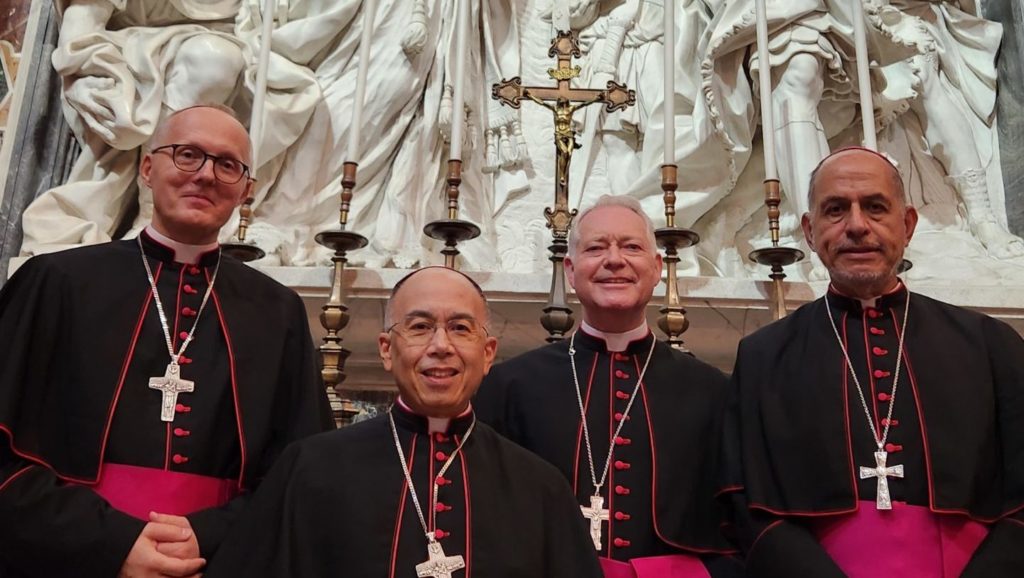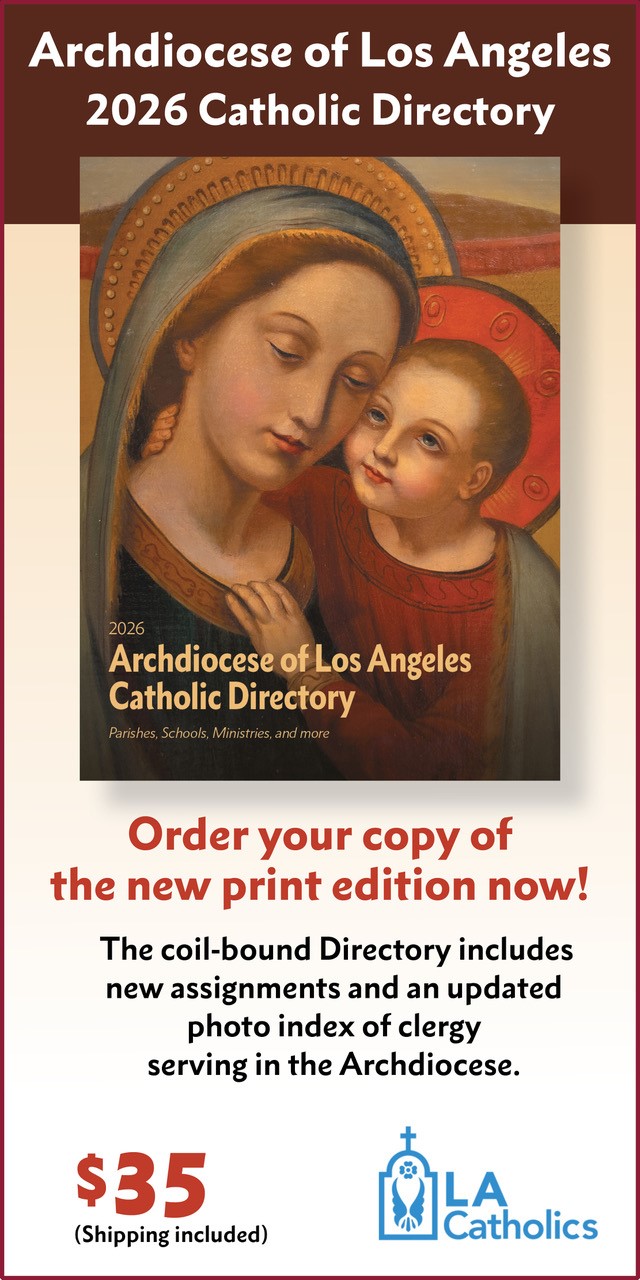For a Catholic priest to be named a bishop, no prior training, achievements, or degrees are necessarily required.
The closest thing the Church has to a learning certificate for new bishops is a weeklong formation program in Rome (sometimes referred to as the “baby bishops course”) where they spend time with one another, Vatican officials, and the pope himself.
But for LA Auxiliary Bishop Matthew Elshoff, the most helpful experience of this year’s course came at an unlikely moment: standing in silence before the tomb of St. Peter with dozens of his fellow rookie bishops from around the world as he waited his turn to pray before his relics.
“That was the formative moment,” said Elshoff. “It’s a powerful experience to realize you’re at the tomb of St. Peter, that you’re connected to him in a very unique way through your episcopal ordination.”
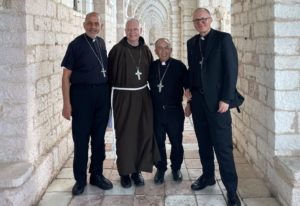
A year after that ordination, the “totality” of his new responsibilities hadn’t fully sunk in for Elshoff. “I’m still trying to get my head around the fact that I’m one of those who have been chosen.”
Luckily for Elshoff and his three fellow (somewhat) new LA auxiliaries, Bishops Albert Bahhuth, Brian Nunes, and Slawomir Szkredka, there were plenty of opportunities for that kind of reflection during a special trip to Italy last month, where they spent a week visiting holy sites before attending the Sept. 15-22 course in Rome. The trip marked almost exactly one year since they were ordained as bishops by Archbishop José H. Gomez on Sept. 26, 2023.
Of the nearly 300 bishops who attended the course, the LA delegation stuck out for one peculiar reason: the pope sometimes appoints two, occasionally three auxiliary bishops for a large diocese at one time. But four? Last year’s LA appointments remain the only time Francis has done so in his nearly 11 years as pope.
“People noticed,” Nunes told Angelus after returning from the course. “We were together a lot, and we were by far the biggest kind of ‘pack’ of bishops there. People did comment on our closeness.”
According to Elshoff, more than one observer remarked on how “fraternal” they seemed together. “People would say, ‘you’re having too much fun.’ ”
Perhaps the most memorable comment came from Francis himself. At the end of a two-hour private meeting inside the Vatican’s Apostolic Palace with the nearly 300 bishops participating in the course, each prelate had a chance to greet the pope and shake his hand. The first of the LA “pack” to reach him was Bishop Szkredka, who reminded Francis in Spanish where he was from and who he’d come with.
“I think he used the word cuadrilla” in his response, recalled Szkredka. The Spanish word literally translates to a group of four, but colloquially can refer to a squad of workers or a posse of friends.
The course itself was organized differently this year than in the past. For the first time, bishops from more established dioceses like Los Angeles shared some sessions with new bishops serving in “mission territory” where the Church is less established, like Africa and Asia.

And instead of having bishops tour the various departments of the Roman Curia, the departments came to them this time, with officials presenting to the new bishops gathered at Rome’s Pontifical Urban University on the work of their respective dicasteries and topics including social media, artificial intelligence, and how to improve the process for couples preparing to get married.
Afterward, the bishops were put in small discussion groups sorted by native language, a welcome surprise.
“We were warned that it was all going to be in Italian with translation, and that it would be tedious,” said Bahhuth. “But talking to people with the same language was very helpful, it broke down all the lecturing.”
Nunes said he found the discussions with bishops from very different parts of the world especially helpful.
“One of the biggest eye-openers for me was hearing bishops in places like Africa and India talk about how the internet and social media is hurting even their young people, and affecting their participation in church,” he said. “That had not even occurred to me. I thought that was a First World problem.”
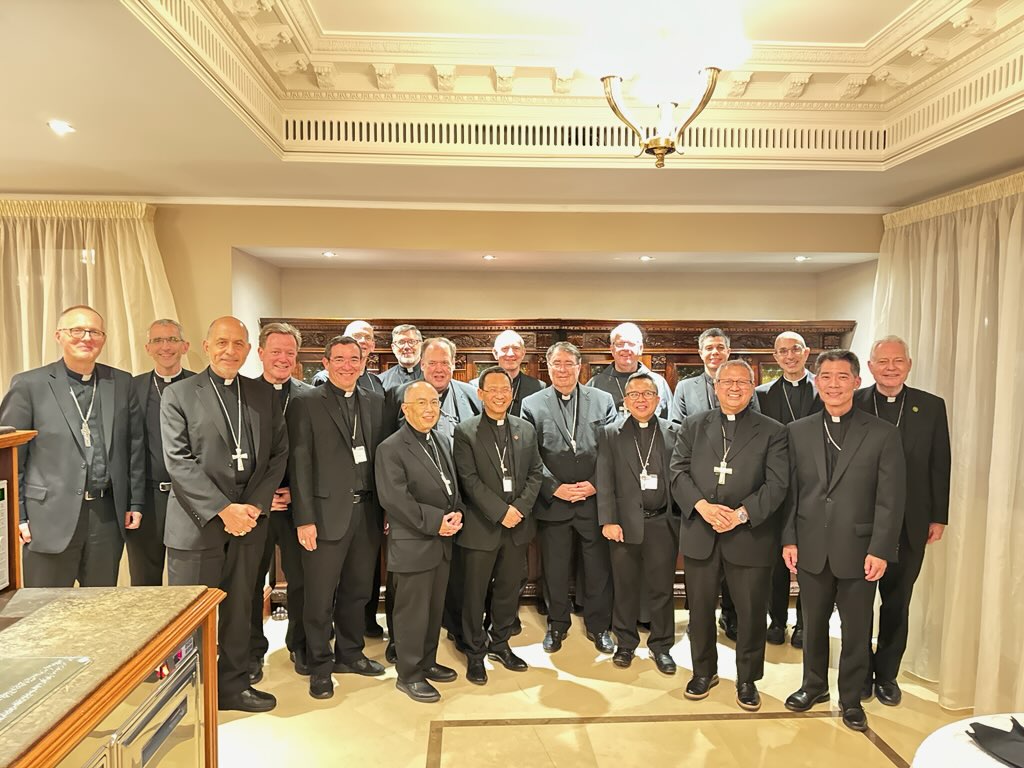
The discussion in Szkredka’s group turned personal, with bishops sharing about the fateful moment they received the phone call informing them of the pope’s decision.
“It was interesting to see how it was very different for each one of us,” said Szkredka. “Spiritually, we were all in different places when we got the call.”
The man charged with making that phone call to future American bishops, Apostolic Nuncio to the U.S. Cardinal Christophe Pierre, also happened to be in Rome that week. The LA auxiliaries had dinner with Pierre twice during their trip, including once at Casa Santa Maria, the residence for American priests studying in Rome, together with 14 other recently appointed U.S. bishops.
Before the start of the course, the California “quadruplets” visited several pilgrimage destinations around Italy, including Florence and the southern town of Corato, home of Servant of God Luisa Piccarreta, an Italian mystic who died in 1963 at the age of 81 after spending most of her life bedridden.
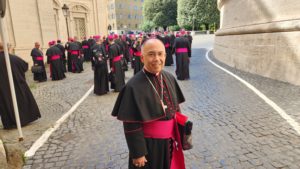
There were also stops in Assisi and the town of La Verna, both important places in the life of St. Francis. They went to Pietrelcina, hometown of Padre Pio, and San Giovanni Rotondo, where the legendary saint spent most of his years as a priest. Those were the places where Elshoff’s Capuchin connections proved helpful, to say the least.
“Being with a Franciscan opened many doors for us,” said Bahhuth.
An American friar in Assisi arranged for them to celebrate a private Mass at Francis’ final tomb. In San Giovanni, Elshoff secured permission for a private, late night viewing of Pio’s body, a tour of the different rooms where he lived, and Mass in the small cell where the saint celebrated the Eucharist during the two years he was suspended by Church authorities.
For Elshoff, the only sour note was the absence of Bishop Marc Trudeau, LA’s one other active auxiliary. Trudeau attended the course in 2018, a few months after his appointment as a bishop. That didn’t stop the quadruplets from inviting him this summer.
“I told them, ‘This is for you guys, not me,’ ” Trudeau said with a laugh.

Looking back on the course six years later, Trudeau remembers it mostly as an experience that helped him assimilate what it means to belong to the College of Bishops.
“In the talks that are given, they don’t give you any secret passwords or anything like that,” Trudeau told Angelus.
“A lot of it is stuff they’ve probably heard before, but you’re hearing it in Rome, with all these bishops that were ordained the same time as you. It puts it in the context of the universal Church, and I think that’s really the key thing.”
